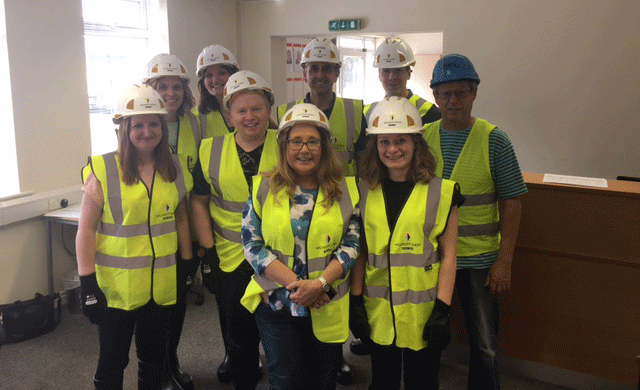On Tuesday last week, the Civic Theatre team (now based at Hippodrome HQ on the Horsemarket) was lucky enough to be given a tour of the Hippodrome site by Sean McNicholas, Operations Manager for Willmott Dixon. The construction company are also running these tours for members of the public. Indeed the first tours proved so popular they were fully booked within a week – so watch this space for news of more!
Arriving at the site office, we are all issued with boots (mine were on the roomy side; if you have small feet, bring thick socks!), hi-vis jackets, gloves, and helmets. So far, so fetching, but essential when we are going to be show around a working building site, so we all don our outfits willingly. I do, though, make the mistake of putting on my gloves back-to-front, a schoolgirl error that our Director of Fundraising and Development points out in whispered tones so as not to embarrass me in front of the seasoned building site stalwarts from Willmott Dixon (or indeed any of the more practical-minded of our own theatre staff).
First, we’re shown into the outside space between the Hullaballoon and Hippodrome sites – what was the courtyard and the Civic Theatre’s conservatory bar, which has been knocked down. It feels huge and it’s thrilling to imagine what it’s going to become. On the other hand, without the red plush seats, the stalls feels smaller, and it takes all our imagination to conjure up a vision of what it used to be like, let alone how it’s going to look when it’s finished. Then we go through the function room and along the dressing room corridor, stopping in number five - Signor Pepi’s flat - to pay our respects. For the last eighteen months before the theatre closed for refurbishment, Pepi’s ghost shared this room with the marketing and audience development staff, and I find myself squatting in the place where my old desk and chair used to be. After that, we visit what until recently were the quarters for the rest of the theatre’s office staff. The roof has been removed and all the walls have been pulled down. The hot sun beating down on our hard hats, everyone marvels at this bare, open space where there used to be offices, desks, photocopiers, toilets. When the theatre re-opens this will be a glass atrium where the audience will enter the building and be able to access all floors by stairs or lift.
After that, we proceed to Pepi’s Bar. Instead of being a place for audience members to sip wine and beer before the show and during the interval, this large space is going to be a dedicated education centre. But rest assured the theatre won’t run dry: other spaces are set to become bars.
We end the tour on the scaffolded stage, looking out into the shell of the auditorium. Following in the footsteps of Anna Pavlova, Tommy Cooper, Dame Vera Lynn, Sarah Millican and so many other performers who have graced our stage during its history, it’s fascinating to imagine what they would think about what we are seeing now. The gilded plasterwork is covered with protective board and the orchestra pit has filled with an inch or so of water. The auditorium looks small and bare. With a final glance it’s time to say a silent farewell and move on.
We can’t believe how quickly the work had progressed so far. Our beautiful theatre has been stripped right back to its Edwardian timbers. But we don’t feel sad to see it like that. The feeling is of excitement, as we began to imagine it full of people of all ages from all over the region: watching shows, drinking coffee, participating in workshops, and enjoying the theatre for another century and more.

